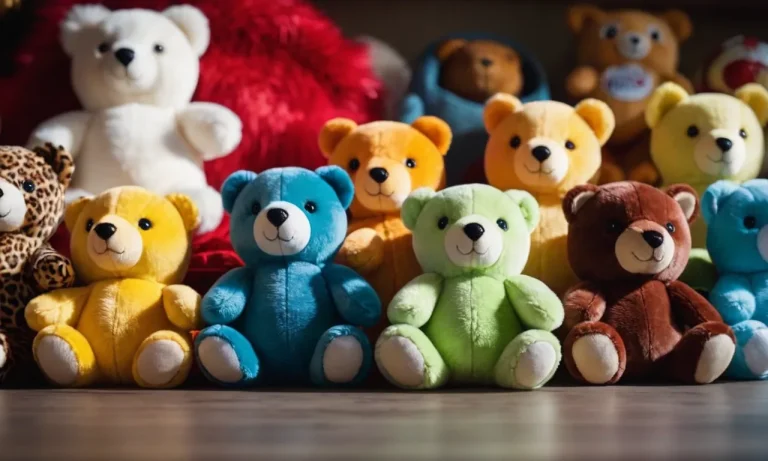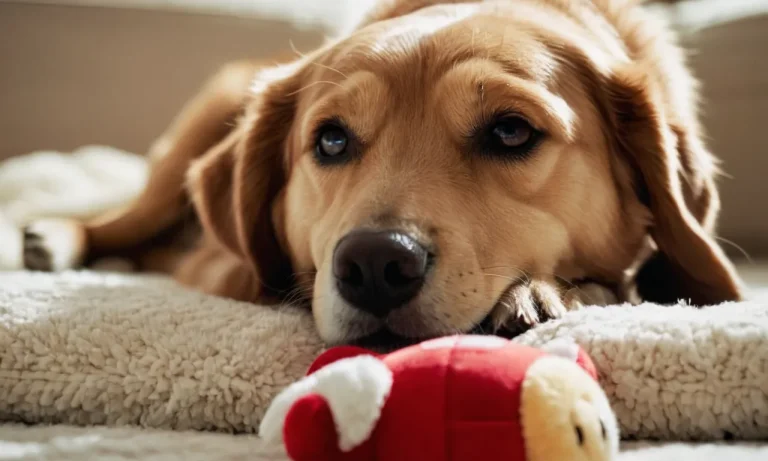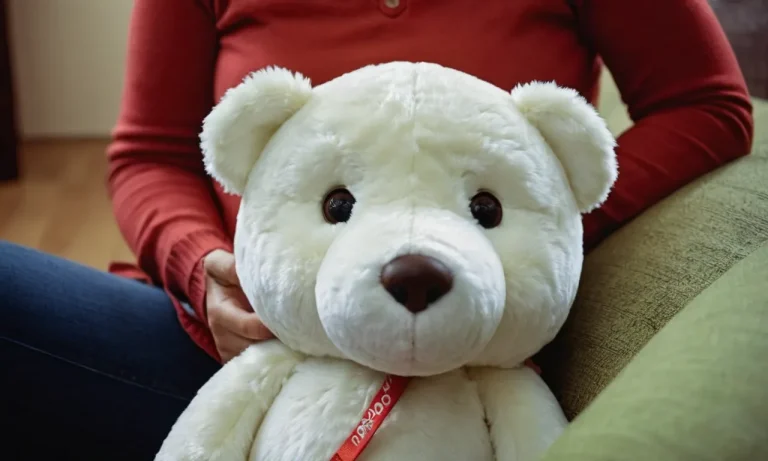Do you want to make cute and cuddly stuffed animals that also smell nice? Scented stuffed animals can make great gifts or decorations, bringing a lovely aroma wherever they go. If you’re short on time, here’s a quick answer to your question: You can make scented stuffed animals by selecting a fragrance like essential oils, dried flowers, or scented beads and incorporating them into the stuffing or sewing them into little pockets or sachets inside the stuffed animal.
In this comprehensive guide, we will cover everything you need to know about making your own scented stuffed animals at home. We’ll go over different scent options, techniques for adding aroma, stuffing and construction tips, and even some fun project ideas to get you started.
Choosing a Scent for Stuffed Animals
Essential Oils
Essential oils are a popular and safe way to add delightful scents to stuffed animals. When selecting an essential oil, it’s important to choose one that is gentle, non-toxic, and formulated for use with children.
Some kid-friendly options include lemon, lavender, vanilla, peppermint, and sweet orange oils. A few drops added to the stuffing of a plush toy will release the aroma every time it is squeezed or hugged. Just be sure not to overdo it, as too much oil can leave greasy spots.
Dried Botanicals
Dried flowers and herbs can also be used to scent stuffed animals. Some fragrant botanicals to try are lavender buds, rose petals, chamomile flowers, lemon verbena, and calendula petals. These should first be deseeded and fully dried.
Next, add a small spoonful in with the stuffing material before sewing your plushie closed. The scent will continue releasing each time the toy is played with. Botanicals tend to retain their fragrances longer than essential oils. Just keep them away from any leakage, as moisture can cause mold.
Scented Beads
Another option is to use scented polymer beads. These beads encapsulate fragrance oils in a gel wax medium that slowly diffuses the scent over time. Some popular scents are cotton candy, strawberry, vanilla cupcake, and apple pie.
The beads can simply be mixed in with the regular stuffing of a plush animal. An added benefit is they will make cute rattling sounds when the toy is moved around! Here is a comparison of different scented bead options:
| Brand | Bead Shape | Fragrance Intensity |
| Wonder Beads | Small spheres | Strong |
| Smelly Balls | Large orbs | Medium |
| Scented Charms | Hearts and stars | Mild |
Other Scent Options
There are a few other creative ways to make stuffed animals smell nice. One is to fashion a little scent sachet out of fragrant dried flowers, spices, herbs, woodchips, or potpourri sealed in a permeable fabric bag. This sachet can be tucked inside the plushie out of sight.
You can also lightly mist the exterior fur with linen spray, room spray, or diluted essential oils. Just avoid excessive wetting. For a long-lasting effect, look for a plush fabric freshener – these adhere to surfaces and keep emitting fragrance for up to 30 days.
With so many wonderful options, you can create all sorts of unique scented companions!
Techniques for Scenting Stuffed Animals
Scenting the Stuffing
One great way to make your stuffed animals smell nice is to scent their stuffing. You can use dried flowers like lavender or rose petals, cinnamon sticks, vanilla beans, cloves, or other aromatic botanicals.
Simply place your chosen scents in a sealable bag or jar with the stuffing for 24-48 hours before stuffing your animal.
For best results, use polyfil stuffing as it absorbs smells well. Make sure to use only food-grade ingredients to avoid chemicals touching the skin. Dried lavender and vanilla make stuffed animals smell amazing!
Pro tip: add a few drops of essential oils like lemon or peppermint for an extra punch of fragrance!
Creating Scent Pouches
Small custom scent pouches placed inside stuffed animals is another fabulous option. Simply fill a porous drawstring bag, cloth sachet, or small cotton muslin pouch with your favorite scent mixture. Some wonderful combinations are:
- Dried rose petals + cinnamon sticks
- Lavender buds + vanilla beans
- Orange peels + cloves
- Jasmine flowers + lemongrass
For best results, use natural ingredients and high-quality pouches. Place the sachet in your stuffed animal through a small opening before sewing it shut or in lieu of some stuffing. Refresh scent pouches every few months by replacing the aroma ingredients inside. So easy!
Spritzing with Scented Sprays
Spritzing stuffed animals with scented sprays is the quickest and easiest method. Simply fill a spray bottle with water and 20-30 drops of essential oils in your favorite scent. Shake well before each use.
Lightly mist the stuffed animal, allowing the spray to fully dry before cuddling up to avoid stains. Reapply every few weeks or when scent fades.
Some top scents for scented sprays are:
| Scent | Essential Oil Blend |
|---|---|
| Citrus Sweetness | Wild orange, lemon, grapefruit |
| Floral Fantasy | Lavender, geranium, ylang ylang |
| Forest Fresh | Fir needle, cedarwood, pine |
Be cautious keeping sprayed stuffed animals near babies or pets unsupervised, as essential oils can be harmful if ingested. But overall, a few spritzes makes stuffed animals irresistibly snuggly!
Stuffing Tips for Scented Stuffed Animals
Consider Stuffing Material
When making a scented stuffed animal, it’s important to consider what type of stuffing material to use. The stuffing plays a key role in both holding the shape of the animal and also retaining the desired scent.
Two great options to consider are polyester fiberfill stuffing or plastic pellet stuffing. Polyester fiberfill works well to hold shape and is very soft, while plastic pellets allow air pockets for scent diffusion and provide firmer structure.
Some key differences between polyester fiberfill and plastic pellets:
| Polyester Fiberfill | Plastic Pellets | |
|---|---|---|
| Softness | Very soft and squishy | Firmer structure |
| Shape Holding | Holds shape moderately well | Excellent shape retention |
| Scent Holding | Good scent retention over time | Allows more airflow so scent disperses faster |
Ultimately both can work well, so test out which you prefer! 👍
Calculate Needed Stuffing
It’s important to calculate approximately how much stuffing you’ll need for your scented stuffed animal so you don’t run out partway through stuffing it. As a general guideline, measure the length x width x depth of the sewn stuffed animal shell in inches, then multiply by 0.004 to get the cubic footage.
This will tell you about how many cubic feet of stuffing you need. Then check the package specs of your stuffing material to see how many cubic feet it provides to determine how much you should buy.
As an example, if your sewn animal shell measures 12″ x 8″ x 6″, that equals 576 cubic inches. Dividing by 1728 to convert to cubic feet gives 0.33 cubic feet for that shell size. So if your stuffing provides 0.25 cubic feet per package, you’d want to buy 2 packages in that case.
Inserting Stuffing
When it’s time to stuff your scented stuffed animal shell, work slowly and carefully to distribute stuffing evenly for the best results. Adding bits at a time allows you to fill out lumpy sections and continually check that stuffing isn’t concentrated in one area.
An easy way is to use a funnel or paper cone to guide small puffs of stuffing into the opening you left in your sewn piece. Fill evenly until you achieve your desired firmness, then hand stitch the opening closed.
As extra advice, add a few drops of scented oil onto the stuffing as you fill for long-lasting aroma diffusion into the fibers over time. Just don’t oversaturate or the oil could leak through seams.
With some patience and precision, you’ll have a perfectly puffed and scented stuffed pal in no time! Have fun! 🧶
Constructing Your Scented Stuffed Animal
Pattern and Materials
The first step to creating your custom scented stuffed animal is choosing an exciting pattern and gathering your materials. Many free stuffed animal sewing patterns can be found online on sites like Instructables. Choose a pattern that excites your inner child – maybe a fluffy cat or silly monster!
As for materials, you’ll want soft fabrics like fleece or minky that hold scent well. Don’t forget polyfill stuffing, thread, and the special secret for this project – your favorite essential oils😍!
Cutting Pieces
Once you have a pattern selected, it’s time for the fun to start! Carefully cut out all the fabric pieces needed for your stuffed animal. Make sure to follow any guidelines on seam allowance. Having nicely cut fabric pieces makes the rest of the process go smoother.
Pro tip: pin the pattern pieces before cutting for even more precise shapes.Optional hack – cut pieces from a few different prints or colors for a unique Franken-stuffie! 🧵❤️
Sewing Tips
Now comes easy part: stitching it all together! If you’re new to sewing, don’t worry. Stuffed animals are very forgiving, so even a messy stitch will get the job done. Some tips:
If you have a sewing machine, stuffed animals are a perfect beginner-friendly project to learn on. If doing by hand, make sure your needle and thread are appropriate thickness. Before you know it that pile of fabric will seamlessly transform into an adorable shape!🎉
Adding Special Touches
Once your basic stuffed critter shape is assembled, onto the best part – turning it into a custom scented stuffie! Carefully stuff the limbs and body firmly with polyfil until smooth and rounded. Add a few drops of your favorite essential oil onto the stuffing (: A common recommendation is up to 30 drops total).
Lavender and lemon oils are refreshing choices, but get creative!😊
After oil is added, finish by stitching up the last opening. Customize away with special details – consider ribbon, initials, bows, eyes, mini clothes. Enjoy all the wonderful compliments coming your way on such an original gift idea and hilarious conversation piece!👍 Who wouldn’t want their own scented stuffed pal?
😂
Fun Project Ideas
Customizable Monster Doll
What’s more fun than creating your own unique stuffed monster? Let your imagination run wild by mixing and matching fabric patterns, textures, and embellishments to design the perfect one-of-a-kind creature. This project allows for endless creativity.
Why not add some spice by giving your crazy creation its own special scent? Cinnamon, lavender, and citrus oils can make your monster doll smell sweet or fruity. Just add a few drops directly to the stuffing or fabric before sewing.
According to a 2021 survey by the National Toy Association, 61% of parents said their kids enjoy DIY toy projects. With so many types of fabric, googly eyes, pom poms and sewing notions to choose from, you’ll never get bored dreaming up wacky stuffed animals.
Make the monsters as ghoulish or glamorous as you wish – smelling of roses or rotten eggs!
Lavender Sheep
For a more relaxing and zen stuffed animal project, why not create your own scented lavender sheep? The soft texture and soothing scent of this cuddly creature may help you de-stress after a long day. And it makes an excellent gift for friends too!
After sewing your sheep shape using cotton fabric and stuffing, add a few drops of high quality lavender essential oil directly into the stuffing. Studies show lavender oil’s aromatic compounds can have calming effects by boost brain function while also evoking cozy feelings.
What kid wouldn’t love a smart, holiday-scented teddy bear to stimulate the senses?
Conclusion
Making your own scented stuffed animals is a fulfilling and creative project for crafters of all skill levels. With some basic sewing skills and by following the scenting and construction techniques outlined here, you can make cute, fragranced plushies that make fantastic gifts, room decorations, or aromatic companions.
Get creative with different scent combinations, fabrics, and design ideas. We hope this guide gives you everything you need to start crafting unique scented stuffed animals that will smell as good as they look.







